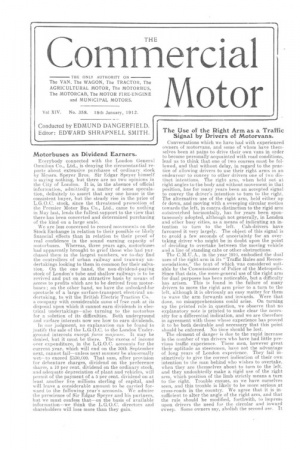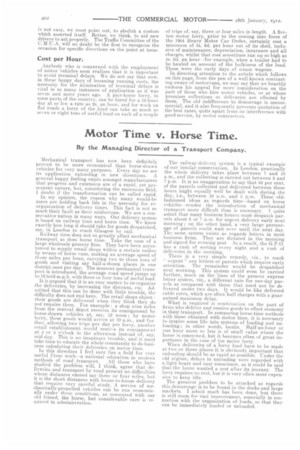Conducted by EDMUND DANGERFIELD. I Editor: EDWARD SHRAPNELL SMITH. j
Page 1

Page 2

If you've noticed an error in this article please click here to report it so we can fix it.
Motorbuses as Dividend Earners.
Everybody connected with the London General Omnibus Co., Ltd., is denying the circumstantial reports about extensive purchases of ordinary stock by Messrs. Speyer Bros. Sir Edgar Speyer himself is saying nothing, but there are no two opinions in the City of London. It is, in the absence of official information, admittedly a matter of some speculation, definitely to assert that any one house is the consistent buyer, but the steady rise in the price of L.G.O.C. stock, since the threatened promotion of the Premier Motor Bus Co., Ltd., came to nothing in May last, lends the fullest support to the view that there has been concerted and determined purchasing of the kind on a large scale_
We are less concerned to record movements on the Stock Exchange in relation to their possible or likely financial effects than in relation to their proof of real confidence in the sound earning capacity of motorbuses. Whereas, three years ago, motorbuses had apparently brought to grief those who had put' chased them in the largest numbers, we to-day find the controllers of urban railway and tramway undertakings looking to them in common for their salvation. On the one hand, the non-dividend-paying stock of London's tube and shallow railways is to be revived and put on an attractive basis by means of access to profits which are to be derived from motorbuses ; on the other hand, we have the unlocked-for spectacle of a large surface-transport electrical undertaking, to wit the British Electric Traction Co. a company with considerable sums of free cash atits disposal upon which it cannot earn dividends in electrical undertakings—also turning to the motorbus for a solution of its difficulties. Both underground and surface interests now see how to earn dividends.
In oar judgment, no explanation can he found to justify the sale of the L.G.O.C. to the London Underground interests except force nonjeure. It may be denied, but it must be there. The excess of income over expenditure, in the L.G.O.C. accounts for the current year, which will end on the 30th September next, cannot fail—unless next summer be abnormally wet—to exceed 2550,C00. That sum, after provision for debenture charges, dividend on the preference shares, a 10 per cent. dividend on the ordinary stock, and adequate depreciation of plant and vehicles, will permit of the payment of a 5 per cent. dividend on at least another live millions sterling of capital, and will leave a considerable amount to be carried forward to the following year's accounts. We admire the prescience of Sir Edgar Speyer and his partners, hut we must confess that—on the basis of available information—we think the L.G.O.C. directors and shareholders will lose more than they gain.
The Use of the Right Arm as a Traffic Signal by Drivers of Motorvans.
Conversations which we have had with experienced owners of motor-vans, and some of whom have themselves been at pains to drive their own vans in order to become personally acquainted with road conditions, lead us to think that one of two courses must be followed, and that without delay, in regard to the practice of allowing drivers to use their right arms in an endeavour to convey to other drivers one of two distinct intentions. The right arm, when held out at right angles to the body and without movement in that position, has for many years been an accepted signal to convey the driver's intention to turn to the right. The alternative use of the right arm, held either up Or down, and moving with a sweeping circular motion towards the left, in contra-distinction to the rigid arm outstretched horizontally, has for years been spontaneously adopted, although not generally, in London and other busy cities, as a means of indicating an intention to turn to the left. Cab-drivers have favoured it very largely. The object of this signal is to avoid a few seconds of uncertainty for an overtaking driver who might be in doubt upon the point of deciding to overtake between the moving vehicle and a line of standing cabs or other obstructions.
The C.M.U.A., in the year 1910, embodied the dual uses of the right arm in its "Traffic Rules and Recommendations," the text of which was considered suitable by the Commissioner of Police of the Metropolis. Since that date, the more-general use of the right arm for dual purposes has been noticeable, but a difficulty has arisen. This is found in the failure of many drivers to move the right arm prior to a turn to the left, although it is obviously an easy matter for them to wave the arm forwards and inwards. Were that done, no misapprehensions could arise. On turning up the printed rule in question, we observe that no explanatory note is printed to make clear the necessity for a differential indication, and we are therefore in agreement with those whose experience has proved it to be both desirable and necessary that this point should be enforced. No time should be lost.
The. element of danger is due to the rapid increase in the number of van drivel's who have had little previous traffic experience. These men, however great their aptitude as steersmen, have not the advantage of long years of London experience, They fail instinctively to give the correct indication of their own intention to Ole man behind who wishes to overtake, when they are themselves about to turn to the left, and they undoubtedly make a rigid use of the right arm, which position of the limb strictly means a turn to the right. Trouble ensues, as we have ourselves seen, and this trouble is likely to be more serious at cross-roads in the country. We agree that it is insufficient to alter the angle of the right arm, and that the rule should be modified, forthwith, to impress upon drivers the need for the circular and inward sweep. Smile owners say, abolish the second use. It is not easy, we must point out, to abolish a custom which asserted itself. Better, we think, to aid new drivers to act properly. The Traffic Committee of the C.MIT.A. will no doubt be the first, to recognize the occasion for specific directions on the point at issue.
Cost per Hour.
Anybody who is concerned with the employment of motor vehicles soon realizes that it is important to avoid terminal delays. We do not say that now, in these happy days of lessening running costs, the necessity for the elimination of terminal delays is vital in so many instances of application as it was seven and more years ago. A pair-horse lorry, in some parts of the country, can be hired for a 12-hour day at so low a rate as 2s. an hour, and for work on flat roads a lorry of the kind can take as much as seven or eight tons of useful load on each of a couple of trips of, say, three or four nines in length. A fiveton motor lorry, prior to the coming into force of the 1904 Heavy Motor Car Order, certainly cost a minimum of 3s. 6d. per hour out of its shed, inclusive of maintenance, depreciation, insurance and all charges, whilst that cost sometimes ran up so high as 4s. 6d. an hour—for example, when a trailer had to be hauled on account of the bulkiness of the load. Those were the early days of steam wagons. In directing attention to the article which follows on this page, from the pen of a well-known contracting owner of motorvans, we may say that we heartily endorse his appeal for more consideration on the Part of those who hire motor vehicles, or at whose premises collections or deliveries are effected by them. The old indifference to demurrage is uncommercial, and it also frequently prevents quotation of the best rates, quite apart from its interference with good service, by motor contractors.






















